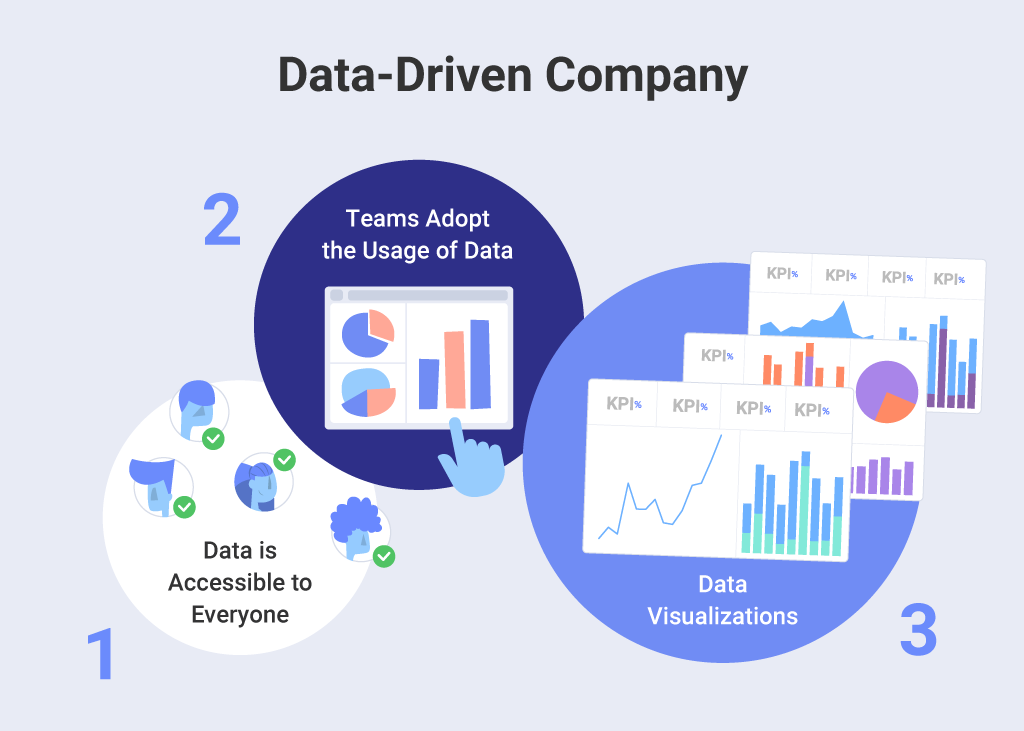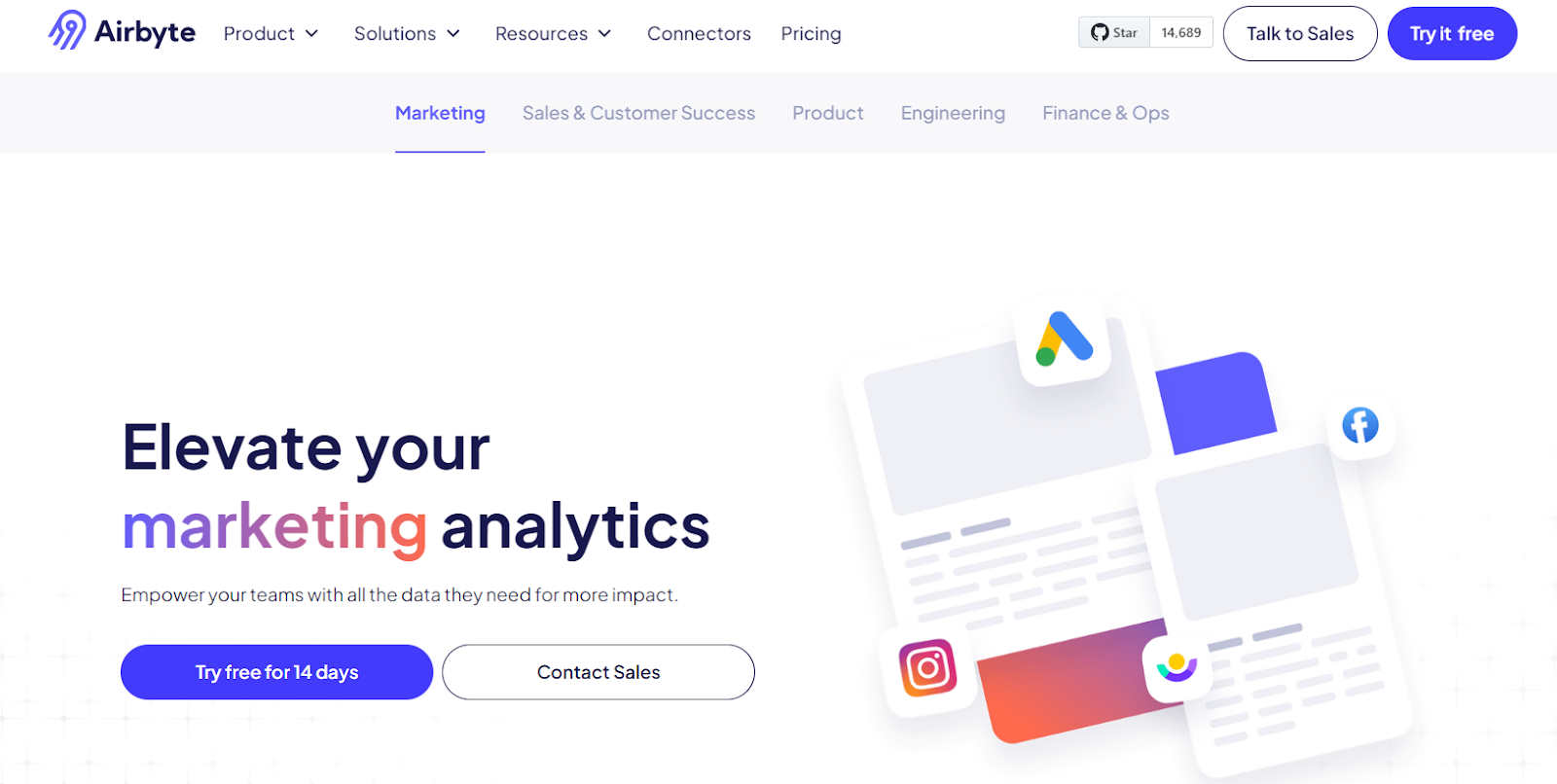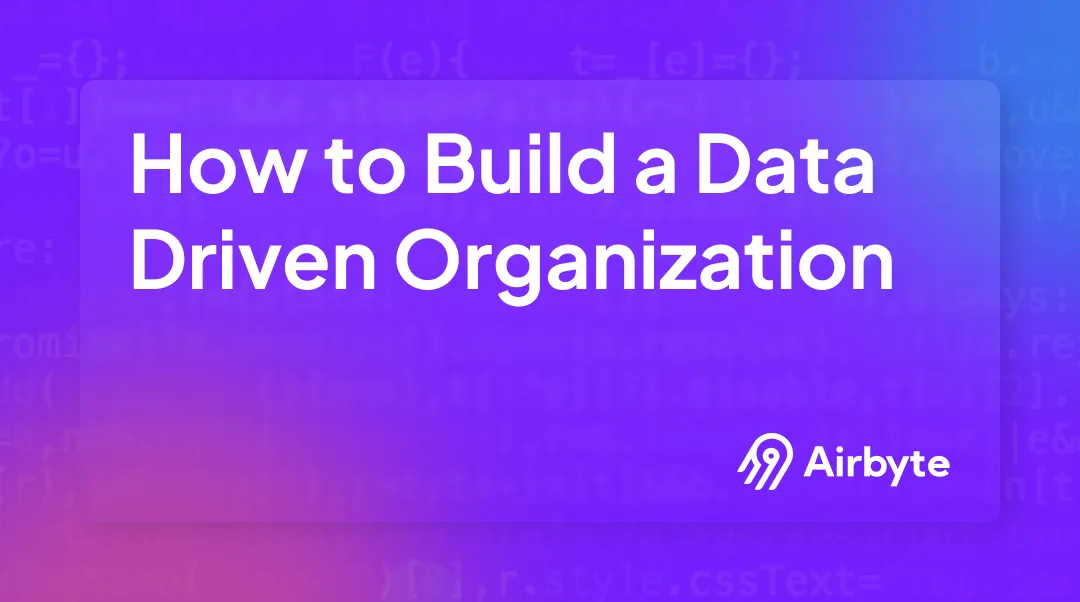How to Build a Data Driven Organization And Its Benefits
Summarize this article with:
✨ AI Generated Summary
A data-driven organization relies on data to guide decisions, streamline operations, and foster innovation by implementing clear policies, data integration, and a strong data culture. Key steps include establishing a data-driven decision-making culture, ensuring data accessibility, prioritizing security and privacy, and appointing a Chief Data Officer to oversee data initiatives.
- Benefits include improved efficiency, deeper customer insights, increased revenue, and stronger security.
- Challenges involve data silos, quality issues, lack of skills, technology investment, and cultural resistance.
- Tools like Airbyte simplify data integration, enhance accessibility, and accelerate insights through automation.
A data-driven organization leverages information to guide strategic decisions and enhance operations. It establishes clear policies and procedures for data collection, storage, security, and access. Implementing a data-driven organization will allow you to utilize appropriate data management and analytics tools to support data-driven decision-making.
In this article, you’ll explore the steps of becoming a data-driven organization, including its characteristics and benefits.
What is a Data-Driven Organization?

Being data-driven means relying on information to make decisions and shape strategies. Instead of guessing, you use data to back up your choices. In a data-driven organization, data is used everywhere, from figuring out how to sell products to making customers happy. It's not just something that happens on the side—it's at the core of how you operate workflows.
In other words, to be data-driven means valuing information, ensuring everyone understands it, investing in tools to work with it, and following rules to use it responsibly. This way, you can adapt to changes, understand what your customers want, find new ways to grow, and avoid later problems. Overall, the goal is to use data to make smarter decisions, do better, and keep growing.
Steps to Build a Data-Driven Organization
Here are six foundational steps to build a data-driven organization:
Implement Data-Driven Decision-Making Culture
It involves using data to inform and evaluate an organization's decision-making process before committing to action. This can lead to more confident decisions, improved proactiveness, and cost savings. Here’s how you can achieve that:
- Implement data analysis workflows, including cleaning and visualization.
- Establish processes for gathering, analyzing, and interpreting data to inform strategic decisions.
- Execute a data-driven culture of decision-making by training employees on data analysis tools and techniques.
Data Integration and Accessibility
Making data integration and accessibility easier involves using standardized data formats across different data sources to organize data. This allows teams to query and comprehend relationships between data. It can be achieved through data consolidation, which allows for increased data accessibility, improved team communication, and real-time work reports. Here's what you need to do:
- You can invest in data integration tools and platforms that streamline the process of moving data from various sources into a centralized location.
- Ensure that the data governance practices are implemented to ensure consistency and reliability in data integration efforts.
Expanded Role of a Chief Data Officer (CDO)
The role of a CDO is becoming more important in data-driven organizations. CDOs are responsible for generating measured business outcomes and developing rules, standards, and procedures to manage data and ensure quality. Achieving this is possible through the following:
- Establish a dedicated data leadership role within your organization, such as a CDO, to oversee data initiatives.
- Empower your CDO with resources and authority to drive data-driven initiatives and foster a culture of data excellence.
Foster Data Sharing Within and Between Organizations
Improved data sharing within and between organizations can lead to increased success in showcasing the value of data and analytics. Data marketplaces can be used to share, trade, and supplement data, allowing your business to create original data products and gain knowledge from them. To accomplish this, follow these steps:
- Use data-sharing platforms and technologies to foster a collaborative data-sharing environment.
- You should also encourage cross-functional teams to share insights and best practices to facilitate a culture of knowledge exchange and innovation.
Prioritize Data Security
You must develop a robust data security strategy to identify and mitigate potential risks. To make this happen, consider the following:
- Implement security measures such as encryption, access controls, and monitoring tools to safeguard sensitive data assets.
- Use clear information to make intelligent decisions about data-related risks.
- Artificial intelligence tools can process large volumes of data and identify areas of high risk, fostering data security.
Enhanced Data Privacy
It requires carefully treating personal identifiable information (PII) and implementing a comprehensive privacy program across the organization. This is becoming increasingly important as governments enact new legislation to protect consumer privacy.
- Establish privacy policies and procedures that align with regulatory requirements and industry standards.
- Define guidelines for data collection, specifying information type and usage purposes.
- Implement protocols for obtaining consent, data retention, disposal, and regular privacy assessments.
- You can consider conducting regular privacy assessments and audits to ensure compliance and mitigate privacy risks.
What are the Benefits of a Data-Driven Organization?
Some benefits of building a data-driven organization include:
Streamlined Processes
Data empowers you to analyze and streamline your processes, leading to greater efficiency, improved decision-making, and cost reduction. By using data driven insights to inform process design, you can eliminate unnecessary steps, automate tasks, and ensure consistent execution across all operations. Data analysis can also help you understand how your processes are functioning and where improvements can be made, and can be applied to various business functions, like managing payroll outsourcing or marketing cost, to optimize operations and reduce costs, allowing for smoother workflows.
Fuels Innovation
You can uncover new opportunities and develop innovative products and services that address customer needs by studying customer data, market trends, and competitor insights. Data can also be used to refine existing offerings by identifying areas for improvement and testing new features, ensuring you stay ahead.
Deeper Customer Insights
By analyzing demographics, purchase history, and website interactions, data empowers you to understand your customers on a deeper level. This customer intelligence can be used to personalize experiences, tailor marketing campaigns with laser focus, and ultimately cultivate stronger customer satisfaction.
Increased Revenue
Leverage data as a roadmap to identify new sales opportunities and product development. By analyzing market trends and competitor data, you can find gaps and use data to create products and services that resonate with customers. Additionally, data facilitates the optimization of pricing strategies by providing insights into purchase behavior and trends. Through detailed analysis, you can adjust pricing dynamically, segment customers effectively, and monitor performance metrics to maximize return on investment and maintain a healthy revenue stream.
Strengthens Your Security Posture
You can proactively pinpoint and address potential security threats by simply analyzing data. It helps to expose areas of vulnerability, allowing for targeted security measures to be implemented. This proactive approach helps safeguard your organization from cyberattacks and other security breaches.
What are the Challenges of Building a Data-driven Organization?
Building a data-driven organization empowers you to utilize the power of information for better decision-making, improved efficiency, and a competitive edge. However, the road to a data-centric culture isn't easy. Here are 5 key challenges you might encounter:
- Data Silos: Information may be scattered across various departments and systems in your organization, creating data silos. This fragmented scenario makes accessing and integrating data for comprehensive analysis difficult, hindering your ability to leverage data for better decision-making.
- Data Quality Issues: Data inconsistencies and inaccuracies can be a significant challenge. Also, unclean data leads to unreliable insights and undermines trust in data-driven decisions. You'll need to establish data governance practices and cleaning routines to ensure the quality and consistency of your data.
- Lack of Data Skills: A data-driven culture requires employees at all levels to be comfortable using data. Employees lacking widespread data literacy and analytical skills may struggle to interpret data and translate it into actionable insights. You might need to invest in training programs that can empower your workforce to use data effectively.
- Investment in Technology: Building a data-driven organization requires a robust technological infrastructure. You may need to invest in data storage solutions, data management tools, and potentially new analytical software. These investments require careful planning and budgeting to ensure you have the right tools for the job.
- Overcoming Cultural Resistance: Shifting to a new culture can meet resistance from those comfortable with traditional, intuition-based decision-making. Fear of losing control or facing new processes can create roadblocks. Here, clear communication and leadership buy-in are essential for overcoming resistance and getting everyone on board.
Become a Data-Driven Organization with Airbyte

Airbyte can significantly aid your journey toward a data-driven organization in several ways.
It lets you handle common challenges like data fragmentation by acting as a bridge, seamlessly connecting the data sources and streamlining the flow of information.
Here’s what Airbyte offers:
- Simplified Data Integration: Airbyte helps you streamline the process of moving data from various sources (databases, applications, cloud services) into a central location like a data warehouse or data lake. This eliminates the need for manual data transfers or custom coding, making data readily available for analysis.
- Increased Accessibility: With Airbyte, you can empower employees across the organization to have access to the data they need. Its user-friendly interface and pre-built connectors for a vast range of sources (350+) make data extraction easier.
- Quick Synchronization: Airbyte’s Change Data Capture (CDC) technique lets you sync only the changes made since the last time your data was synchronized.
- Faster Insights: By automating data pipelines and simplifying access, Airbyte reduces the time it takes to get valuable insights from your data. This allows teams to make data-driven decisions faster and adapt to changing situations more effectively.
- Advanced Automation with PyAirbyte: PyAirbyte is a Python library that provides programmatic access to extract data from multiple connectors supported by Airbyte. You can leverage PyAirbyte to automate complex data workflows and integrate Airbyte with custom scripts or existing data pipelines.
Conclusion
Building a data-driven organization isn't just a trend; it's a necessity in the competitive business world. Using data smartly helps you better understand your customers, make smarter decisions, and grow steadily. From knowing what your customers want to improve how you work, data is the key to success.
But it's not always easy. There are challenges like getting everyone on board and making sure your data is accurate and safe. Yet, with the right mindset and investment, you can overcome these challenges.

